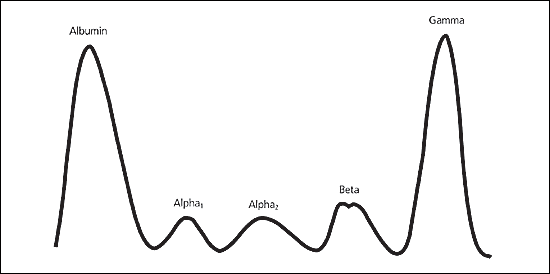Contents
Plasma protein electrophoresis: diagnosis and interpretation
Serum protein electrophoresis is an examination performed from a blood test which allows the diagnosis and monitoring of many diseases such as monoclonal immunoglobulin, hypergammaglobulinemia and more rarely hypogammaglobulinemia.
What is serum protein electrophoresis?
Serum protein electrophoresis (EPS) is a medical biology examination. Its objective is the separation of proteins present in the liquid part of the blood (the serum). “These proteins notably play a role in transporting numerous molecules (hormones, lipids, drugs, etc.), and are also involved in coagulation, immunity and the maintenance of blood pressure. This separation will make it possible to identify and quantify them ”, specifies Dr Sophie Lyon, medical biologist.
Protein analysis
After a blood test, the proteins are analyzed by migration in an electric field. “They then separate according to their electrical charge and their molecular weight, which makes it possible to identify them and spot anomalies.” EPS will allow the separation of six protein fractions, in decreasing order of their migration speed: albumin (which is the major serum protein, at a presence of about 60%), alpha 1-globulins , alpha 2-globulins, Beta 1 globulin, Beta 2 globulin and gammaglobulins. “Electrophoresis makes it possible to diagnose certain pathologies linked to poor functioning of the liver or kidneys, to an alteration of the immune defenses, to inflammatory symptoms or to certain cancers”.
Indications for prescribing an EPS
The conditions for prescribing an EPS were specified by the Haute Autorité de Santé (HAS) in January 2017. The main reason why an EPS is performed is the search for a monoclonal immunoglobulin (monoclonal gammopathy, or dysglobulinemia). This will migrate most of the time in the area of gamma globulins and sometimes in the area of beta-globulins or even alpha2-globulins.
When to carry out a PSE?
You must perform an EPS when you are in front of:
- A high level of circulating proteins;
- Unexplained increase in sedimentation rate (VS);
- Repeated infections, in particular bacterial (search for an immune deficiency responsible for hypogammaglobulinemia);
- Clinical or biological manifestations (hypercalcemia, for example) suggesting the occurrence of myeloma or blood disease;
- A suspicion of inflammatory syndrome;
- Possibly cirrhosis;
- Any exploration of osteoporosis.
Reference values of an EPS
Depending on the protein, the reference values should be between:
- Albumin: 55 and 65% or 36 and 50 g / L.
- Alpha1 – globulins: 1 and 4% i.e. 1 and 5 g / L
- .Alpha 2 – globulins: 6 and 10% or 4 and 8 g / l
- .Beta – globulins: 8 and 14% or 5 and 12 g / L.
- Gamma – globulins: 12 and 20% or 8 and 16 g / L.
Interpretation of electrophoresis
Electrophoresis will then identify groups of increased or decreased proteins in the serum. “Each blood protein will form bands of different widths and intensities depending on their quantity. Each characteristic “profile” can be interpreted by the doctor ”. He may, if necessary, prescribe additional examinations.
Anomalies identified by the EPS
Among the anomalies found:
- A decrease in the level of albumin (hypoalbuminemia), which can be caused by malnutrition, liver failure, chronic infection, myeloma or even water overload (hemodilution).
- Hyper-alpha2-globulinemia and a decrease in albumin are synonymous with an inflammatory state. A fusion of the beta and gamma fractions indicates cirrhosis.
- A decrease in gamma globulins (hypogammaglobulinemia) is observed in case of dysfunction of the immune system. On the other hand, the rate increases (hypergammaglobulinemia) in a situation of myeloma, monoclonal gammopathies and autoimmune diseases (lupus, rheumatoid arthritis).
- An increase in beta globulins can mean the presence of iron deficiency, hypothyroidism or biliary obstruction.
According to the HAS, it is recommended to send the patient for further advice:
- If the patient’s clinical presentation suggests hematologic malignancy (bone pain, deterioration of the general condition, lymphadenopathy, tumor syndrome);
- in the event of a biological abnormality (anemia, hypercalcemia, renal failure) or imaging (bone lesions) suggesting organ damage;
- in the absence of such symptoms, the patient for whom at least one of the first-line examinations is abnormal, or whose serum monoclonal immunoglobulin is IgG? 15 g / L, IgA or IgM? 10 g / L;
- if the patient is under 60 years of age.
Recommended treatment
The treatment of an anomaly of electrophoresis is that of the pathology that it reveals.
“For example, in case of total hyperprotidemia due to dehydration, the treatment will be rehydration. If there is an increase in alpha globulins due to an inflammatory syndrome, treatment will be that of the cause of the inflammation. In all cases, it is the doctor who, using this examination as well as other additional examinations (blood test, radiological test, etc.), will make the diagnosis during the consultation and will prescribe the treatment adapted to the pathology. found ”.










